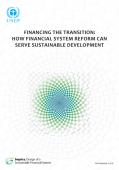
Making the Jump: How crises affect policy consensus and can trigger paradigm shift outlines the dynamics behind the financial regulatory paradigm shift that began in 2008-2009. It seeks to identify parallels with and differences from the slower moving, even more consequential, global climate change crisis, and the fitful, still under way, policy paradigm shift that the United Nations Environment Programme (UNEP) and other stakeholders are trying to support and facilitate linking economic sustainability, financial regulation, markets, and climate change. The following ten observations are developed in this paper:
The Equator Principles are a voluntary code of conduct and a risk management framework for determining, assessing and managing environmental and social risks in projects, such as energy or infrastructure projects. Since their foundation in 2003, they were lauded for integrating social and environmental assessment practices into project assessments. Critics reason, however, that without fundamental implementation efforts and enforcement, the Equator Principles will not contribute to any change with respect to effects of projects on sustainable development.
Lenders and Investors Environmental Liability: How much is too much? presents an overview of Lender Environmental Liability (LEL) and Investor Environmental Liability (IEL) regimes and issues. Environmental harm and degradation are often irreparable. Therefore, our assumption is that precaution is the main objective of any international and domestic environmental legal regime. The paper explores the conditions under which LEL/IEL can be the effective tool to promote precaution. To illustrate our premise, we created a model based on Nash’s game theory in an attempt to universalize some basic concepts in the design of these systems. By using Nash’s game theory we aim to answer the question presented in the title of our paper: how much is a too much environmental liability for a financial institution to bear?
We argue that full environmental liability (where financial institutions bear unlimited liability) may have the perverse effect of incentivising them to internalize any duty of care, in case they bear full liability.
